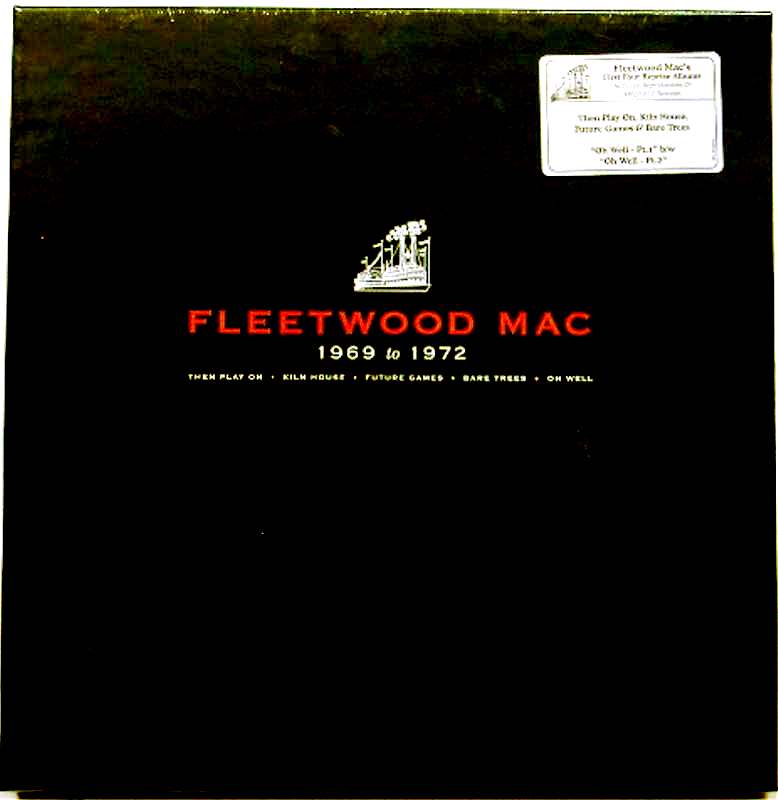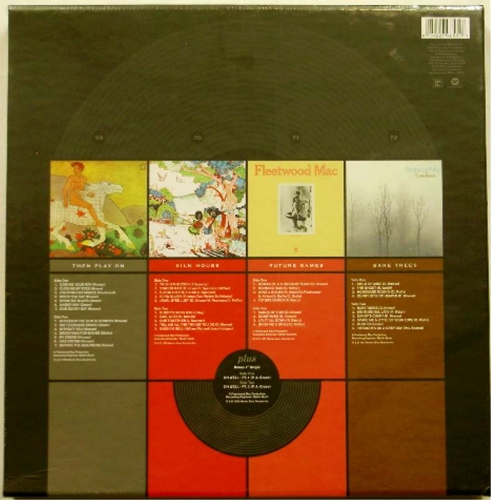Fleetwood Mac 1969-1972 features four complete albums – Then Play On (1969), Kiln House (1970), Future Games (1971) and Bare Trees (1972) – housed in a striking black slipcase. To ensure superb sound quality, Chris Bellman at Bernie Grundman Mastering cut the lacquers for all four albums. The records look as good as they sound thanks to authentically reproduced packages, including gatefolds for Then Play On and Kiln House and single sleeves for Future Games and Bare Trees. As a bonus, the set also comes with an exclusive replica of the original 1969 7-inch single of “Oh Well – Pt. 1” b/w “Oh Well – Pt. 2.”
The set follows the band through an early transitional period. With Kiln House, Fleetwood Mac began moving toward a more melodic pop sound on songs like “Mission Bell” and “One Together.” At the time, the band included: Jeremy Spencer (guitar, vocals, piano), Danny Kirwan (guitar, vocals), John McVie (bass) and Mick Fleetwood (drums). Christine McVie was at the recording sessions and contributed backing vocals and the album’s cover art, but she did not join the band until shortly after the album was finished.
The band’s shift toward pop and folk styles continued on Future Games with songs like “Show Me A Smile” and “Morning Rain.” This marks the first Fleetwood Mac album with Christine McVie as a full band member as well as the Mac debut of Bob Welch on guitar. The line-up stayed the same for Bare Trees, which boasts a consistently strong collection of songs like McVie’s “Spare Me A Little Of Your Love,” Kirwan’s “Dust” and Welch’s “Sentimental Lady.” Although Kirwan was a dominant figure during the recording, penning half of the songs, this would ultimately be his last appearance on a Fleetwood Mac album.
"The Fleetwood Mac story is an episodic saga that spans more than 30 years. It is the saga of a British blues band formed in 1967 that became a California-based pop group in the mid-Seventies. In between came a period where Fleetwood Mac shuffled personnel and experimented with styles, all the while releasing solid albums that found a loyal core audience. Despite all the changes, two members have remained constant over the years: drummer Mick Fleetwood and bassist John McVie, whose surnames provided the group name Fleetwood Mac. Although most rock fans are familiar with the lineup that includes Lindsey Buckingham and Stevie Nicks – by far the longest-running edition of the band, responsible for the classic albums Fleetwood Mac and Rumours – the group possesses a rich and storied history that predates those epics. Earlier Fleetwood Mac lineups included guitarists Peter Green, Jeremy Spencer, Danny Kirwan and Bob Welch.
"Fleetwood Mac emerged when Green, Fleetwood and McVie, who were all expatriates from British bandleader John Mayall’s Bluesbreakers, decided to form a band. McVie and Fleetwood had been playing with Mayall, a British blues legend, since 1963 and 1965, respectively, while Green replaced Eric Clapton (who exited to form Cream) in 1966. Initially a quartet, the original Fleetwood Mac also included guitarist Jeremy Spencer and then expanded with the addition of Danny Kirwan prior to their second album. Not surprisingly, the group’s first two U.K. albums – Fleetwood Mac (1968) and Mr. Wonderful (1968) – were heavily blues-oriented. “Black Magic Woman,” a Peter Green song from the latter album, later became a major hit for Santana. In 1969, Fleetwood Mac recorded at Chess studios with American blues musicians, including Willie Dixon and Otis Span; it was released as the two-volume Blues Jam in the U.K. and as Fleetwood Mac in Chicago in the U.S. By decade’s end, however, Fleetwood Mac had begun moving from traditional blues to a more progressive approach. Around this time, the group adopted its distinctive “penguin” logo, based on zoo-lover and amateur photographer McVie’s interest in the birds.
"There are arguably three “definitive” Fleetwood Mac lineups. One of them is the blues-oriented band of the late Sixties, which arrayed three guitarists (Green, Spencer and Kirwan) around the rhythm section of Fleetwood and McVie. They are best represented by 1969’s Then Play On, a milestone in progressive blues-rock. After Green’s exodus in mid-1970, the remaining members cut the more easygoing, rock and roll-oriented Kiln House. Early in 1971, a born-again Spencer abruptly left the band during a U.S. tour to join the Children of God. The second key configuration found Fleetwood, McVie and Kirwan joined by keyboardist Christine McVie (born Christine Perfect, she’d married bassist McVie) and guitarist Bob Welch, a Southern Californian who became the group’s first American member and a harbinger of new directions. This configuration produced a pair of ethereal pop masterpieces, Future Games (1971) and Bare Trees (1972). Kirwan, who was having personal problems, was asked to leave in August 1972. The remaining foursome, joined by new recruits Dave Walker (vocals) and Bob Weston, recorded Penguin (1973); sans Walker, they cut Mystery to Me (1973). Again reduced to a quartet with Weston’s departure, they released Heroes Are Hard to Find in 1974.
"Finally, the platinum edition of Fleetwood Mac came together in 1975 with the recruitment of Lindsey Buckingham and Stevie Nicks. The San Francisco duo had previously cut an album together as Buckingham-Nicks. Drummer Fleetwood heard a tape of theirs at a studio he was auditioning, and the pair were drafted into the group without so much as a formal audition. This lineup proved far and away to be Fleetwood Mac’s most durable and successful. In addition to the most solid rhythm section in rock, this classic lineup contained strong vocalists and songwriters in Buckingham, Nicks and Christine McVie. Male and female points of view were offered with unusual candor on the watershed albums Fleetwood Mac (1975) and Rumours (1977)." - Rock & Roll Hall of Fame
Fleetwood Mac Fleetwood Mac 1969-1972 Contents:
LP1 - Then Play On
1. Coming Your Way
2. Closing My Eyes
3. Fighting For Madge
4. When You Say
5. Show-Biz Blues
6. Underway
7. One Sunny Day
8. Although The Sun Is Shining
9. Rattlesnake Shake
10. Without You
11. Searching For Madge
12. My Dream
13. Like Crying
14. Before The Beginning
LP2 - Kiln House
1. This Is The Rock
2. Station Man
3. Blood On The Floor
4. Hi Ho Silver
5. Jewel Eyed Judy
6. Buddy's Song
7. Earl Gray
8. One Together
9. Tell Me All The Things You Do
10. Mission Bell
LP3 - Future Games
1. Woman Of 1000 Years
2. Morning Rain
3. What A Shame
4. Future Games
5. Sands Of Time
6. Sometimes
7. Lay It All Down
8. Show Me A Smile
LP4 - Bare Trees
1. Child Of Mine
2. The Ghost
3. Homeward Bound
4. Sunny Side Of Heaven
5. Bare Trees
6. Sentimental Lady
7. Danny's Chant
8. Spare Me A Little Of Your Love
9. Dust
10. Thoughts On A Grey Day
7"
A1. Oh Well - Pt. 1
B1. Oh Well - Pt. 2

